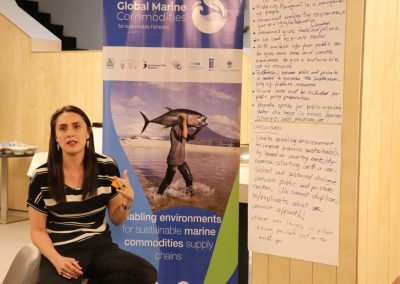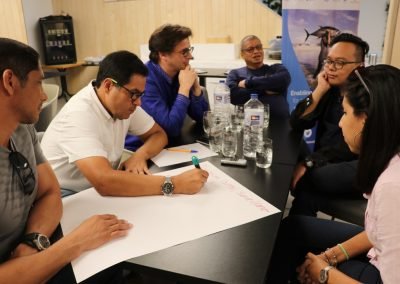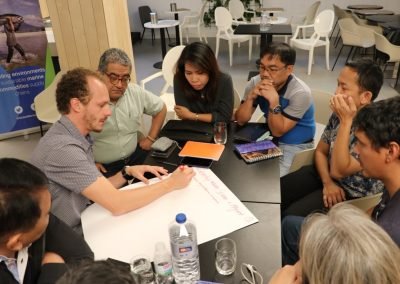For thousands of years, fishing has supported the many towns and villages built along the banks of the Galician Rias, or fjord-like bays that spread inland from the Atlantic Ocean in this hilly landscape in northwestern Spain. In 2017, Galicia reported more than 200,000 metric tons of total seafood landings, which represents more than 500 million Euros in sales[1]. Over 70% of seafood consumed in Spain comes off the 4,400 registered fishing vessels in Galician ports, where the industry employs approximately 4.6% of the active population[2]
In a place whose cultural identity and the economy is so closely tied to the fishing sector, it is a government priority to ensure that fish and marine invertebrate stocks are harvested responsibly and sustainably. To prevent overexploitation of the fishery resources, the regional authorities have worked in close coordination with scientists, fisherfolk and the private sector to design management systems that are now internationally recognized for their effectiveness.
 The people and institutions involved in these successful systems shared their experiences, best practices and knowledge with public and private sector delegations from the three countries that receive support from the Global Marine Commodities (GMC) Project in an in-situ peer-to-peer knowledge exchange event organized by project facilitating partner, Sustainable Fisheries Partnership (SFP) from June 26-28 2019.
The people and institutions involved in these successful systems shared their experiences, best practices and knowledge with public and private sector delegations from the three countries that receive support from the Global Marine Commodities (GMC) Project in an in-situ peer-to-peer knowledge exchange event organized by project facilitating partner, Sustainable Fisheries Partnership (SFP) from June 26-28 2019.
“In Galicia, it is very important to properly plan for effective fisheries management. This management consists of three interacting elements,” said Marta Villaverde Acuña, Deputy Director of Fisheries and Seafood Marketing, Regional Government of Galicia.
“The first element is to have scientific data regarding the status of fisheries stocks; the second is that there must be structured mechanisms for consulting fisherfolk and arriving at a consensus about management measures; and the third is that managers consider the social and economic impact of fisheries management measures and strive to guarantee the long-term sustainability of fisheries activities.” Marta Villaverde Acuña, Deputy Director of Fisheries and Seafood Marketing, Regional Government of Galicia.
Those three “elements” were common themes throughout the peer-to-peer knowledge exchange. Ecuadorian, Indonesian and Philippine representatives from the fisheries and planning government agencies, as well as from the private sector were given the opportunity to interact directly with fisheries regulators from the Galician government, with port authorities who monitor and collect data about fish catch and sales, and with fisherfolk from Cofradias, or local fishing development organizations who participate in management plan construction.
The Cofradias were a focus point of the trip, as they represent a unique model of fisherfolk organization that participates directly in decision making regarding the management of Galician fish and marine invertebrate stocks.

“In the Philippines, similar to the Cofradias, the Technical Working Groups (TWG) are the bodies or platforms that serve as a venue where government entities and fisherfolk can discuss about fishery management activities,” said Rafael Ramiscal, Chief of the Capture Fisheries Division of the Bureau of Fisheries and Aquatic Resources (BFAR).
 The Cofradias and Cofradia federations have been granted territorial fishing rights by the government of Galicia, and are actively involved in setting harvest quotas, monitoring fishing effort and catch, establishing bans and deciding on the distribution of fishing effort. Through its engagement with the cofradias, the Galician government has been able to effectively involve the private sector in management decision making, thereby improving compliance and facilitating data collection.
The Cofradias and Cofradia federations have been granted territorial fishing rights by the government of Galicia, and are actively involved in setting harvest quotas, monitoring fishing effort and catch, establishing bans and deciding on the distribution of fishing effort. Through its engagement with the cofradias, the Galician government has been able to effectively involve the private sector in management decision making, thereby improving compliance and facilitating data collection.
Viviana Jurado, a biologist from the Ecuadorian National Institute of Fisheries (INP), attended the learning exchange and commented that the event helped reinforce the importance of public-private partnerships to establish good fisheries management plans.
The INP is the Ecuadorian government agency in charge of studying and monitoring fish stocks within Ecuador’s national jurisdiction, and Jurado is currently working on an innovative partnership with the Ecuadorian Small Pelagic Fishery Improvement Project to study the Small Pelagic Fishery stocks.
“Galicia presents a model to learn from, in which there is a very good organization of small-scale fishers in cofradias, who are considered by the regional administration in decision-making,” said Enrique Alonso, Latin America Fisheries Director for SFP.
“The Ecuadorian industry is noticing that independent of which country you are talking about, all the participants here follow the same technical guidelines for fisheries monitoring and research,” Jurado said. “I hope to see the private sector representatives return to Ecuador and share this vision with their industry partners.
Participants were also able to visit several different lonxas or controlled seafood auction centers where catch data is collected, and artisanal and industrial fishers are provided a space to sell their catch to first buyers. At the lonxas, participants learned about the Pesca de Galicia electronic system, which was established by the regional government as a tool to collect data about fishing activities in the Galician jurisdictional waters.
 Through the Pesca de Galicia online system, fisherfolk register their fishing journeys, fishing gear utilized, location of catch, total sales by species and other data in designated ATM-like computer stations located at fishing ports across the region. The system can also provide updates to fishers regarding fishery or area closures.
Through the Pesca de Galicia online system, fisherfolk register their fishing journeys, fishing gear utilized, location of catch, total sales by species and other data in designated ATM-like computer stations located at fishing ports across the region. The system can also provide updates to fishers regarding fishery or area closures.
“Our platform ensures that we collect good information at the first sale of the seafood product, which allows us to trace the product from the location it was caught or collected and further along the supply chain,” Acuña said.
“It also ensures that we have reliable and constantly updated information about our fisheries to inform sectorial decision making. For example, the platform can help Sardine fishers track how far along they are toward reaching their total allowable catch of say 40 tons in a season. Once a week the fishers can log in to the system and check the total sum of sardines that he/she has sold this season to make sure they do not pass their limit.”
Rommel Soto, from the Philippines Cephalopods Producers and Exporters Association, said he was impressed with the Pesca de Galicia platform, which facilitates data-informed adaptive management of the Galician fisheries.

Participants also had the opportunity to share their strategies for addressing challenges related to starting up, implementing and funding the distinct Fisheries Improvement Projects (FIPs) and national platforms (dialogue working tables) supported by the GMC Project.
Regarding the national platforms, Ramiscal commented that “with support of the GMC project, the Blue Swimming Crab and the Octopus Technical Working Groups have institutionalized a form of consultative fisheries management where any management measure is constructed together as a group. This helps improve fisherfolk adoption and compliance with management measures.”
The GMC Project-supported FIPs have multi-year work plans and budgets established to implement actions needed to achieve sustainability certification from either the Marine Stewardship Council, the International Fishmeal and Fish Oil Reduction Standard or simply to improve fisheries sustainability performance of key fisheries
Marinelle Espino, from the Philippine Association of Crab Processors (PACPI), is overseeing the implementation of the Blue Swimming Crab FIP in the Philippines that receives support from the GMC Project. Espino said the primary challenge facing her FIP, which has existed for more than 4 years, is that many of the actions that have been taken to date by the FIP do not necessarily respond to the MSC pre-assessment of the fishery.

The knowledge exchange event in Galicia provided managers and seafood company representatives with ideas, tools, and models to adapt to their own contexts. Participants expressed their excitement to return to their respective countries and share their new knowledge with colleagues who participate in the GMC Project-facilitated sustainable marine commodity platforms.





